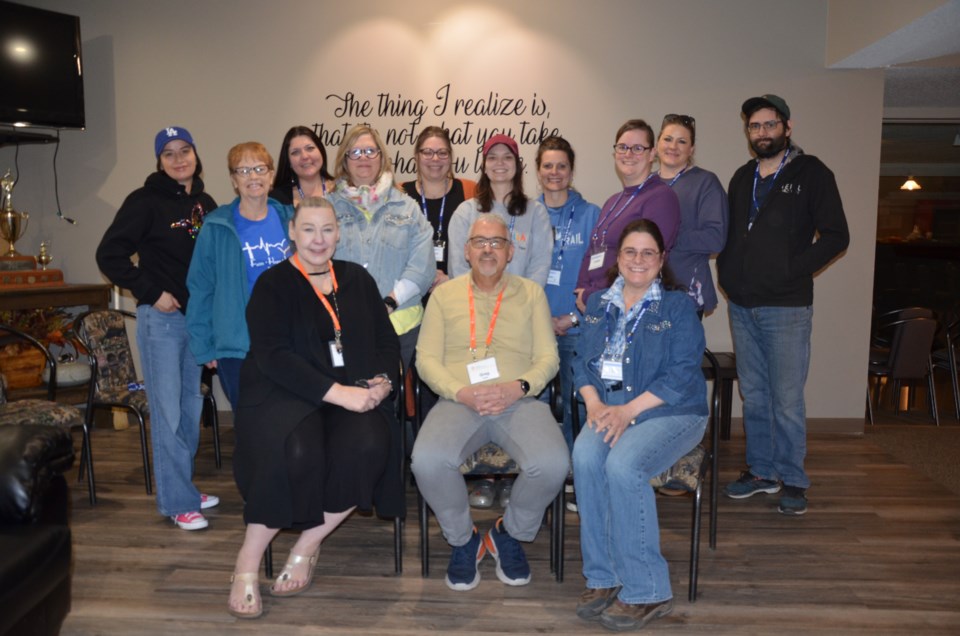MALLAIG – Suicide can be prevented. That’s according to Greg Lane, trainer at the Centre for Suicide Prevention (CSP), a non-profit based in Calgary.
Lane is among the trainers who spent time in Mallaig on April 20 and 21 for a two-day, skills-based workshop on intervening with a person at risk of suicide, teaching Applied Suicide Intervention Skills Training (ASIST).
The workshop was sponsored by the Rural Mental Health Network, as well as the Demeria Memorial Fund, a Mallaig-based non-profit working to raise awareness on suicide and mental health. Their sponsorship lowered the registration fee to $60. Throughout Canada, ASIST training typically costs three to fives times more.
Some of Rural Health Mental Network and Demeria Memorial Fund's other efforts include working together on fundraisers for mental health.
RELATED: Community shows up to support mental health at comedy night
During the ASIST workshop, “Participants learned to recognize when someone may have thoughts of suicide,” says Lane.
Some ways a person can recognize somebody thinking about suicide includes giving away their possessions or showing more withdrawn behaviour.
“Often, there may be a loss or an event that might trigger someone to have thoughts of suicide – or what we call getting into the river of suicide,” says Lane.
Participants were also taught how to talk or approach someone they believe may be thinking of committing suicide.
Intervention
Lane clarified they are not teaching people to be professionals. The applied training could be used by anybody. It’s about helping people understand what they can do to help someone they believe to be at risk.
Lane says that if you know someone who may be at risk, it’s recommended that you clearly and directly ask them if they’re having thoughts of suicide. Then, listen to that person and help find them more support.
A direct and clear inquiry of, “Are you having thoughts of suicide, [or] are you thinking of killing yourself?” directed at the person conveys that you are open for a deep, personal discussion, says Lane.
“Being direct... that’s important – because there’s a stigma around suicide,” explained Lane. “You’re letting that person know that it’s okay for them to talk about it with you. And that person then hopefully feels relief that they have someone... who’s willing to talk to them about [suicide]."
Taking this approach helps overcome the stigma around suicide. It also conveys to the person at risk that their feelings are valid and that you care for them; and “that you understand... that there’s a reason that person has come to have thoughts of suicide,” adds Lane.
It’s not about saving the person at risk completely from their thoughts of suicide, “But offering them to be safe right now,” says Lane.
Helping people at risk of suicide is just the first step. You are helping them “get out of the water,” says Lane. As it would also allow you to create a plan to help them further. “That might include involving professionals,” like doctors, he adds.
Rae Michaud, one of the organizers of the ASIST workshop in Mallaig, and a member of Demeria Memorial Fund’s board, agreed with Lane.
Suicide prevention training does not mean “you’re training to be counsellors,” says Michaud. “You’re just training to help assist this person to get them to the next level,” which would be to get them to actual counsellors or doctors – whoever could provide them with that support system.
Statistics
Suicide is a consistent leading cause of death in Canada and Alberta among youth and young adults, according to a 2020 study published in the Journal of Medical Internet Research Protocols.
The claim is consistent to a data compiled by CSP from 2012 to 2022. During the 10-year period, 6,556 Albertans committed suicide, including 77 youth under the age of 15; 382 youth between the age of 15-19; and 565 people between the age of 20-24. Ages 25-29, 30-34, 35-39, 40-44, 45-49, 50-54, averaged about 600 deaths for each age group within the same 10-year period.
Men account for about 75 per cent of deaths by suicide in Canada, according to information from the Mental Health Commission of Canada. The number is also consistent with Alberta as indicated by the CSP's data compilation.
Many studies have attempted to answer the question of why that may be the case, but a commonality among them claims that women are more likely to attempt suicide – while men are more likely to die from the attempt due to their use of more lethal means. It's also estimated that for every suicide death, there are 20 suicide attempts, according to the World Health Organization.
Talk to someone
For those who are thinking of suicide, Lane urges them to find someone they can talk to. “I think many people feel alone and they may not feel comfortable talking to someone about it." He understands it can be difficult to do so, “[But] talk to someone – don’t feel like you’re alone.”
If you or someone you believe is thinking of suicide, call or text the 24/7 Suicide Crisis Helpline at 9-8-8. Call 9-1-1 immediately if someone is at immediate risk.
Mental health and addiction services information are also available at 211 Alberta or you may also call 2-1-1 for referrals and crisis support.



